Laguna de Bay’s fishers and defenders
A multimedia report by Eunice Lei Wu and Gabriel Endona
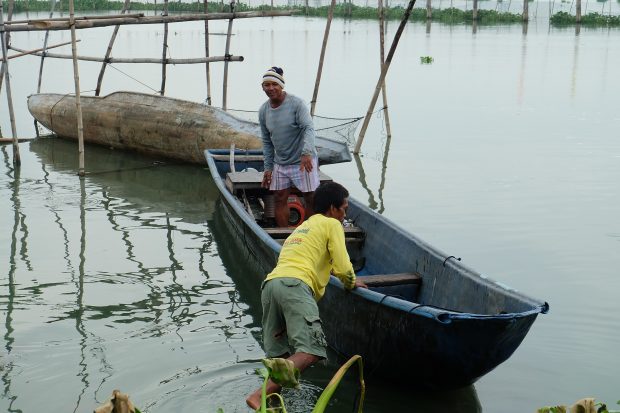
Ronnie Molero and Marlon Valenzuela prepare their boat for the day’s fishing.
THEIR day starts early, from the small hours of the morning to daybreak. The boats they use are slim and long, shorn on its sides by constant use and time. But the boats are sturdy and more than capable of carrying at least seven people. They can travel from one end of the lake to the other. If these had enough gas, that is.
To get the boats out to the baklad (fish pens), it takes around ten minutes of wrestling through the lush fields of water lilies kept at bay by walls of green netting and bamboo poles. One of the reasons the fishermen needed to put up net barriers was to ward off the wild growth. It was a preventative measure. If they don’t build barriers before the lilies grow, they can’t fish.
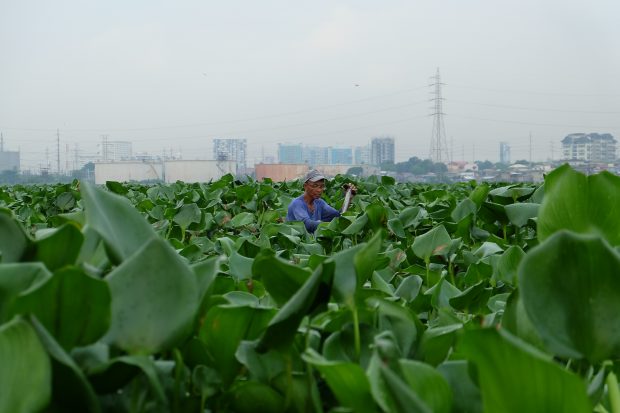
“Ang kasabihan kasi ‘pag sumobra nakakasama,” Mang Larry Protasio, 60, said. He is the President of the Fisheries and Aquatic Resource Management Council (FARMC). His jurisdiction covers the entirety of Laguna Lake. “Kagaya niyan. Lalabas ka ng alas tres ng madaling araw, bago ka makalabas alas singko na. Sasalok ka pa. Pagsalok mo, babalik ka na naman. Bago ka makapasok, alas siete na. Bilasa na isda mo,” he said.
Mang Emil Rongabilla, 59, perched himself nimbly on the baklad’s bamboo poles—no easy feat given the size of the net he carried. He would dip the net attached to yet another bamboo pole about twice his body size into the water and haul out a fish load. The catch can range from just one piece to what seemed like five kilos worth of them. The tiny silver bodies would flail about powerfully in the net, splashing water around the baklad. Yet Mang Emil keeps his balance.
There’s an art to the way Mang Emil released the fish: a practiced flick of the wrist that sent the net arcing gracefully through the air and its catch cleanly onto his boat. These are mostly kanduli and a smattering of tilapia.
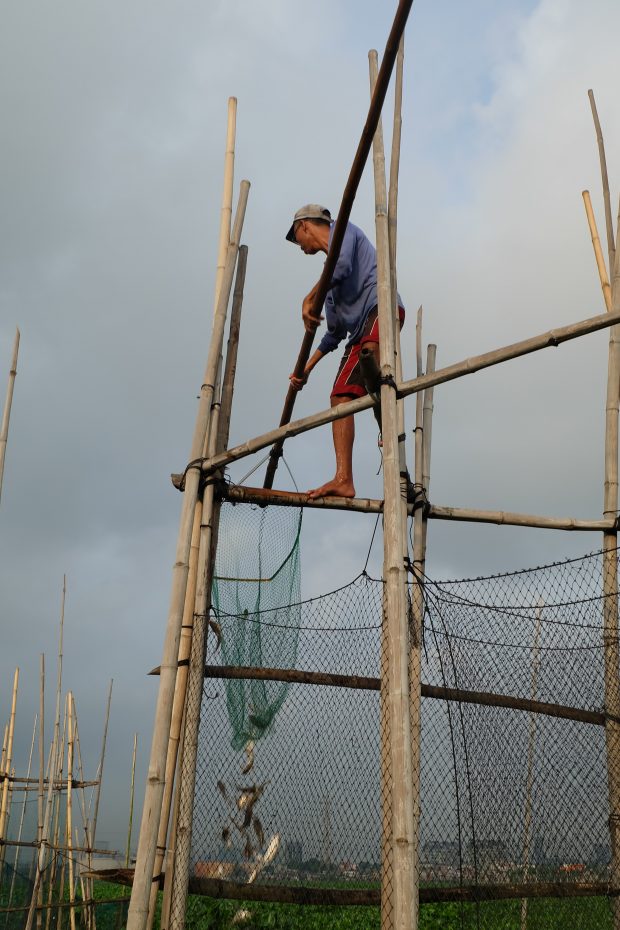
After scooping the fishes from the baklad, Emil then drops them into his boat.
“Hindi na mabenta ang kanduli,” Mang Ronnie Molero, 59, spokesperson of the Save Laguna Lake Movement said. Still, they manage.
This is the life for the average fisherfolk in Barangay Sucat, Muntinlupa. They, like many other fisherfolk in Laguna Lake, have relied primarily on systems of net barriers and baklad to sustain themselves and their families for generations. “Iyong lolo pa ng lolo ko nagdadagat na, hanggang sa ako na ang nagmana,” Mang Larry said.
Duterte’s zero fish pen policy
Just last year, a threat to this way of life emerged in the form of President Rodrigo Duterte’s zero fish pen policy purportedly aimed to rehabilitate the lake. Small fisher folk were quickly alarmed, saying that an absolute zero fish pen policy would effectively spell their doom. “Kung aalisin mo ang mga fish pond—lahat ha, zero—maraming magugutom,” Mang Larry said.
FARMC has around 22,000 members, the registered fishers of the lake. Almost every one of them has a family to support. The lake is a vital fish supplier for the whole of Metro Manila. “Ang ipinaglalaban ng mga mangingisda ay wag i-zero,” Mang Larry said.
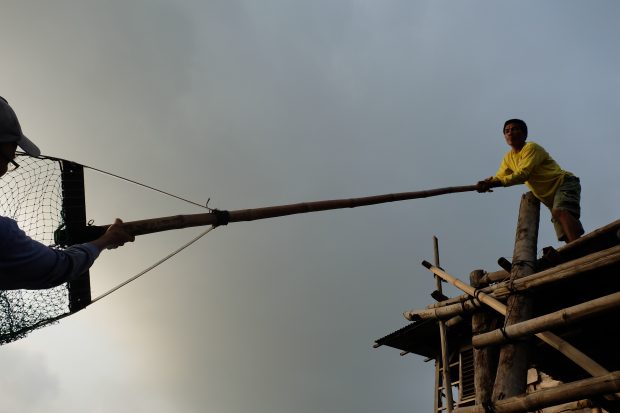
Marlon hands Emil Rongabilla a net attached to a bamboo pole, the primary tool they use to fish.
The Fisheries Code dictates that only 10 percent of an inland body of water is allotted to fishing activities. In Laguna de Bay’s case, it should only be 9,000 hectares of its 90,000-hectare. Currently, about 18,000-20,000 hectares are occupied by baklads, approximately 70 percent of which is occupied by commercial fish pens.
Mang Larry and Mang Ronnie both agree that reducing the occupied areas to the law-mandated 10 percent would in fact benefit small fisherfolk. “Luluwag ang pangisdaan namin. At luluwag din yung mga pwedeng puwesto ng isda na palalakihan,” Mang Larry said.
Former Department of Environment and Natural Resources Secretary Gina Lopez supported the small fisher folk’s demand to leave their baklad alone and only commercial fish pens should be abolished. Lopez however was denied confirmation by the Commission on Appointments. It was a hard blow to the small fisher folk of Laguna Lake.
But Lopez’ non-confirmation gave them some relief. Lopez wanted to transform the lake into an ecotourism zone which would bring more big businessmen who could eventually elbow the fisher folk out of the lake. The lake’s seven islands, each covering 100-hectare areas, are to be transformed as tourist attractions in the Taguig and Muntinlupa areas of the lake. These would then be sold off to the highest bidders. The lake’s intended ecotourist transformation is meant to evoke for the south what the reclaimed areas in Pasay by Manila Bay have become.
Road of perdition
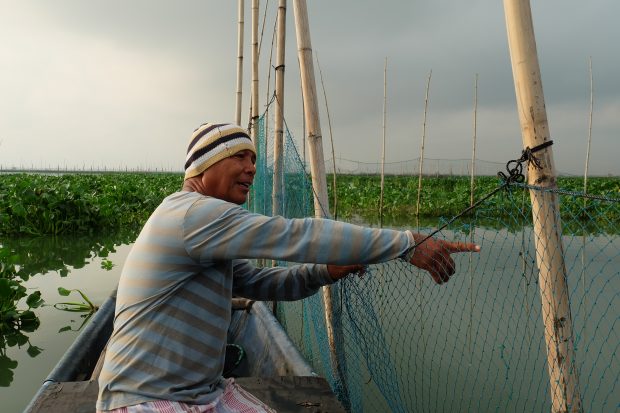
Ronnie points to a kanduli, which made up most of the catch for the day.
The construction of the controversial Laguna Lakeshore Expressway Dike (LLED) presents yet another threat to the lives of those who reside along the lake. The proposed LLED would cut through the lake from Taguig to Calamba and Los Baños in Laguna province. One of the reasons for the LLED is to make travel easier from the metro to the south and ease traffic congestion. Last July 7, the Department of Public Works and Highways opened a recently completed 3.2 kilometer portion of the LLED in Taguig as part of its first phase of construction.
“Kasi ang katwiran nila, nahihirapan daw pumunta ang mga turista sa Pagsanjan Falls dahil traffic na rito,” Virgilio Biñalon, 52, FARMC Sucat president, said. “Puro pambobola ginagawa nila,” he added.
The fisher folk of Laguna Lake cry foul at these developments, saying the private and commercial nature of the projects would eliminate all room for the fisher folk to make a living. “’Di naman pwede ang ecotourism na ang makikinabang lamang ay iilang tao,” Mang Larry said.
The projects would also entail massive reclamation of land and water area. The fisher folk fear backers of Laguna Lake’s conversion into an ecotourism zone as well as the building of the LLED are unaware or deliberately ignoring the fact that certain areas of the projects are situated above the West Valley Fault (WVF). Barangay Sucat itself is reclaimed and a precarious one, according to Mang Virgilio. He said it takes the LLED constructors about 80 feet for a lamppost to be submerged and stabilized. With the LLED seen as a possible initiator of flooding, it would take very little to weaken the soil.
Bagong Alyansang Makabayan’s Muntinlupa Chapter member Anabel San Juan for her part said the Laguna Lake Development Authority has been pacifying the fisher folk and the residents near Laguna Lake about the LLED project while operations still carried on. San Juan recalls the devastation of the 1990 earthquake in Dagupan City. The 7.8 magnitude quake caused parts of the city to sink by about one meter due to soil liquefaction. “’Di ba lumubog ang lupa? Pagkatapos ng lindol umaangat na yung tubig,” she added.
The problem with land reclamation is that reclaimed areas are more prone to soil liquefaction especially in the event of an earthquake, the residents said. They are more alarmed that Laguna de Bay reclamation efforts are on top of a major fault line experts warned is ripe for a major earthquake.
“Kasi tinambakan mo ang tubig. Kukunin din ng tubig yan,” Mang Virgilio said.
Protecting the lake
Their livelihood is not the residents’ sole reason for protecting the lake. For them, it has been the anchor of their lives. It is by the lakeside that they are born and raised. They’ve walked its shores and kissed its waters with the curved edges of their boats.
In Barangay Sucat, the area by the lake is also fertile ground for small-scale farming with yields like kangkong that many families rely on. Many fisher folk have already opt to seek alternative work for when fishing alone cannot sustain a living. In spite of this, the lake still remains a place for them to come back to.
”’Yan ang kaibahan ng dagat. Takbo sila diyan, diyan naghahanap-buhay. Pagka mahina sa dagat, tatakbo na naman sila, magko-construction,” Mang Larry said.
Mang Virgilio, for his part laments at what the future holds for the lake. “Ang problema yung maiiwan natin dito,” he said. “Pag naglakihan ang mga bata anong gagawin natin?” he wondered.
Laguna de Bay’s fisher folks vow to keep their way of life. They say they hope succeeding generations would still have the lake as the center of their lives as both beneficiaries of its blessings as well as its protector. #
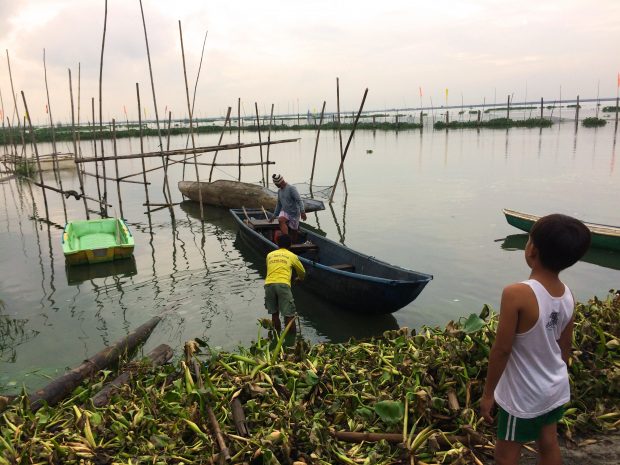
A little boy watches Ronnie and Marlon dock the boat on the lakeside after a day’s work.
